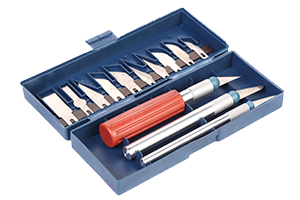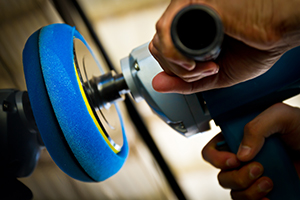How To Clean Acrylic Windows Without Scratching
Acrylic or plexiglass is 1 of the popular materials used in commercial and residential products — and for a expert reason. This clear plastic is shatterproof, transparent, piece of cake-to-use, and highly versatile. Nosotros know because we've been manufacturing acrylic displays for over 40 years. Merely like whatsoever surface, in that location comes a time when acrylic needs to be cleaned. When this type of clear plastic becomes dirty or begins to announced dull, y'all can bet it's time to give it a little TLC.
Regularly cleaning your displays helps promote longevity and clarity, assuasive the material to maintain its shine and transparency. Frequent cleanings should keep the workload light with materials you'll likely already have effectually your home or business organisation. Refer to this guide to notice out all the best tricks and tips for cleaning acrylic.
Easy Cleaning Process

Earlier yous begin cleaning your acrylic or plexiglass panel of fingerprints, dust, and clay, clear the surrounding area of any objects that may obstruct your working space. Always use a microfiber cloth to avoid damaging your panel as paper towels are likely to create scratches when used. Wet the cloth with a recommended cleaning solution or with soapy water. Later on wetting the cloth, start lightly blotting the acrylic then gently spread the solution onto the entire surface. Use the dry side of the fabric to vitrify the expanse and remove any lingering liquid or suds. Avert aggressively rubbing the plexiglass as this may cause scratches.
Additionally, buffing or polishing acrylic reduces the run a risk of future stains, allowing for more time between cleanings. Allow sit for a moment before checking for whatsoever remaining streams. If whatever are left over, rewet the cloth and dry again.
Cull Carefully: In that location are a couple of cleaning items that you'll want to stay abroad from. In fact, using the wrong cleaning production can completely damage your acrylic displays to the point that they go unusable!
- Do not utilize paper towels because they volition non remove scratches and may fifty-fifty cause them. Stick with micro-fiber type of cloth.
- Avoid ammonia-based products, similar Windex or other home drinking glass cleaners, because they contain harmful chemicals that volition actually damage the surface leaving it cloudy looking. Soapy water is the safest and well-nigh effective cleaning solution for acrylic.
Sanitizing Acrylic and Plexiglass Panels to Protect Confronting COVID-19
In the midst of a pandemic, information technology is vital to maintain a healthy, sterile environment for both employees and customers alike. COVID-xix has inverse the face of business for organizations nationwide, and preventative measures must be taken daily in society to help forbid the spread of infectious disease. Many businesses have implemented the employ of protective acrylic or plexiglass sneeze guards, also known equally splash shields, or clear hanging banners to create a barrier between customers and employees. These fixtures must exist cleaned regularly, less harmful germs and bacteria are bound to fester, especially in locations that do not mandate citizens to wear masks in public.
How to clean acrylic and plexiglass sneeze guards?- Wipe down your acrylic panel as often every bit possible, at least between each shift, but ideally multiple times throughout the day. We suggest using cleaning wipes with at least seventy% alcohol, hydrogen peroxide, bleach, isopropyl alcohol or ethyl alcohol, or other acrylic approved disinfectants.
- Use a microfiber cloth in society to avoid leaving scratches in your plexiglass panels, which would requite harmful bacteria more nooks to hide away in and grow. Recent studies have shown that using microfiber fabric eliminates 99% of harmful leaner, microbes, and spores. If surfaces are visibly dingy, they should be cleaned gently using warm water and dishwashing soap prior to disinfection.
- Exist sure to article of clothing disposable gloves when cleaning or disinfecting surfaces, not merely to protect your skin confronting harsh chemicals but to prevent accidental contamination of viruses and leaner. Gloves should be discarded into the trash after each use.
- Prolonged exposure to cleaning materials tin cause clear acrylic to stiffen, crack, or become hazy, then it is vital to properly wipe downwards and dry your sneeze baby-sit after each cleaning in order to maintain the highest quality fixture.
- Information technology is important to mention that y'all should never apply window cleaners or other disinfectants that comprise ammonia, such as Windex, every bit these products volition do more harm than proficient.
Note that there are cardinal differences between cleaning and disinfecting a plexiglass or acrylic splash guard. Cleaning refers to the removal of germs, dirt, and impurities from surfaces. Cleaning does not kill germs, but by removing them, information technology lowers their numbers and the risk of spreading infection. Disinfecting refers to using chemicals to impale germs on surfaces. This process does not necessarily clean dirty surfaces or remove germs, simply by killing germs on a surface after cleaning, it tin can further lower the risk of spreading infection. It is the responsibility of business owners nationwide to practice condom social distancing measures and to make serious efforts to protect their employees and customers akin. Showing your patrons that your coronavirus response can exist taken seriously will go the distance in alleviating any social stresses they may accept in a public space. Make clean and disinfect your social distancing tools such as clear vinyl banners, acrylic shields, and splash guards ofttimes to maintain the healthiest environment for all.
Advanced Cleaning & Repairing Plexiglass
A more elaborate and involved mode to get your acrylic looking as skilful equally new is to scrape, sand, buff, or flame polish the durable plastic. Many manufactures and designers apply these processes for commercial fabrication and custom-made displays. These methods are not for beginners, especially if you're unsure virtually damaging your products. However, when done correctly, the finished surface of the acrylic will look nigh new. With that in mind, try to find someone with a bit of know-how.
-
Scraping

Notice a razor blade or another blazon of sharp scraping tool to eliminate whatsoever machine markings that may be left on the acrylic. Move the abrupt instrument from side to side, evenly scraping off the backlog and scratched acrylic. Be careful not to dig into the acrylic. You can avoid this past fishing the tool at 10 degrees. Using the acrylic scraping method is also keen for shaping any jagged or uneven edges.
-
Sanding
Sanding volition non only remove machining marks simply also produce a matte finish on your acrylic. You can use any form of sander including hand, disc, belt, or drum. The type of tool y'all utilise volition probably depend on the size and surface area of your piece of acrylic.
Sand the acrylic merely similar you would with a piece of wood. Work your way across the surface with a more coarse sandpaper then move on to a finer sandpaper. For deep scratches, nosotros recommend starting with a 220-grit or 320-dust paper and moving up to a 600-dust or 800-grit. Use light pressure and go on the sander moving at all times. This will avoid rut buildup and damage to the acrylic. Always wear a mask when sanding to avoid grit inhalation.
-
Buffing

Stationary polishing wheels are great for buffing acrylic back to a nice clear terminate after its been sanded. To make sure you are less likely to overheat the acrylic, use an viii"-14" bore, ii"-three" wide piece of bleached muslin with bias strips. This will allow the wheel to run much cooler. Make certain you clench the acrylic in place then that it doesn't move when buffing.
The finished quality of the acrylic volition depend on the blazon of smooth compound you lot utilise. A medium cutting compound will event in a glossy cease. A college, luster terminate can be accomplished by applying a fast cutting chemical compound followed by a fine compound. This is a longer procedure but information technology will requite you the best finish.
-
Flame Polishing
Using a normal hydrogen-oxygen torch with a #four or #5 tip, gently cook the sanded, buffed, or machined edges of the acrylic. Doing then volition provide a smooth glossy edge. Beginning by guiding the torch flame across the acrylic edge at a rate of approximately 3" - 4" per 2d. You lot want to oestrus the edges with swift motions. Make certain non to overshoot or heat the acrylic too closely, which will melt the acrylic and wreck the cease. If you move the flame too slowly or close stress, crazing, and bubbles will occur. If done correct, the edges will have a clean, shiny finish that will make your furniture or display really stand out. Lastly, delight be very conscientious whenever using high heat tools!
If All Else Fails...
As you can see, there are many methods for cleaning your plexiglass or acrylic panels. In most cases, users will be able to maintain their fixture with a microfiber fabric and soapy water. However, especially in high-traffic areas, harm is more probable to occur and it is wise to know how to correctly buff out digs, scratches, and other blemishes. If y'all decide that y'all aren't comfortable or take plenty expertise to clean or vitrify your own acrylic simply yet, accept a look at our huge selection of custom acrylic displays! From function signs, to modern podiums, to ballot boxes, and more - at Displays2go we're experts in acrylic fabrication!
Source: https://www.displays2go.com/Guide/How-Clean-Plexiglass-Acrylic-Washing-Tips-Tricks-22
Posted by: tierneycanothed.blogspot.com


0 Response to "How To Clean Acrylic Windows Without Scratching"
Post a Comment